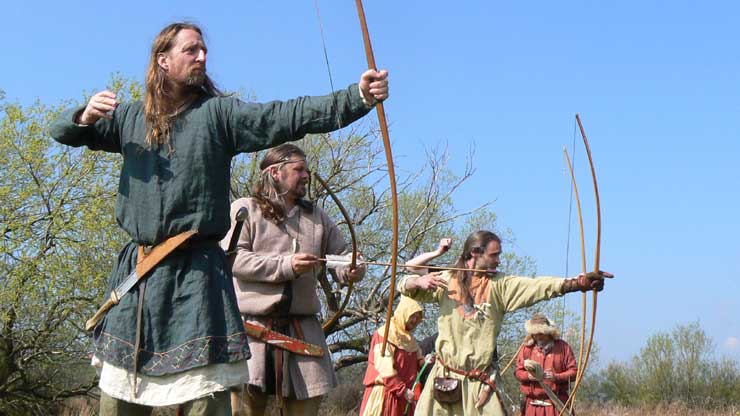Viking archery has a rich and complex history that remains largely untold in popular culture. When we think of Vikings, images of fierce sword-wielding warriors pillaging villages and sailing on grand ships come to mind. While Viking warriors were indeed skilled in close combat, their expertise in archery should not be overlooked.
With their iconic longbows made from durable materials, Norse archers played a crucial role in raids and battles. This article aims to shed light on the fascinating world of Vikings Archery, exploring their extraordinary skills, the tools they used, and its importance in both their daily lives and conquests.
The Significance of Archery in Viking Society
Despite the portrayal of Viking warriors as sword-fighting brutes, the bow and arrow held a prominent place in their society. Archery was an essential skill for hunting, where it allowed the Norse to secure food and resources in their harsh environment. Additionally, archers played a vital role in military campaigns, both for support purposes and as a force that could quickly decimate enemies in battle.
The growing importance of archery in Viking society can be seen within the archaeological record, as numerous bows, arrows, and quivers bearing intricate designs have been uncovered in excavation sites across Scandinavia.
An Overview of Viking Bows
Viking bows were a key element of their archery practice. They primarily used longbows, which were powerful weapons capable of firing arrows great distances with remarkable accuracy. Longbows were crafted from a single piece of wood, typically yew, elm, or ash. A well-maintained Viking longbow could last for decades or even a warriors entire lifetime.
The Efficacy of the Viking Longbow
The advantage of the Viking longbow came from its high draw weight, which allowed for considerable force and precision in shooting arrows. A skilled archer using a longbow could accurately hit targets up to 200 meters away, a feat undeniably useful in hunting and warfare. Moreover, it fired arrows at much greater speed than other bow types of the time, ensuring that adversaries had minimal time to react or take cover.
How to String a Viking Bow
Stringing a Viking bow was a careful and methodical process. Archers began by fastening one end of the string to the bottom of the bow stave. Then, they bent the bow by bracing it against one leg and attaching the other end of the string to the top of the stave. This required immense strength, as Viking bows had a notably high draw weight.
Arrows and Arrowheads
Arrows were just as essential in Viking archery as the bows themselves. Vikings used arrows with a variety of heads, each tailored for specific tasks. Broadhead arrows, with wide, cutting blades, were ideal for hunting large game like deer and elk.
The wide cutting surface of the broadhead inflicted significant damage, ensuring a quick and efficient kill. Meanwhile, in warfare, Vikings employed bodkin arrowheads, which had a small, pointed tip designed to penetrate armor and dispatch opponents quickly.
The Importance of the Bowyer and Fletcher
Within Viking society, the craftsmanship skills of the bowyer and fletcher were highly valued. Bowyers specialized in constructing the bows themselves, carefully selecting and shaping the wood to ensure the finished product was powerful and reliable. Meanwhile, fletchers were responsible for crafting the arrows, choosing suitable materials to create straight shafts and sturdy arrowheads.
Quivers and Bracers: Essential Viking Archery Accessories
For a Viking archer, carrying their arrows in an organized manner was vital. To store arrows efficiently and safely, they used leather quivers, which were slung over their shoulders. These quivers could hold multiple arrows at a time, ensuring a steady supply during battle. Additionally, Viking archers wore bracers on their bow arm to protect their skin from the bowstrings harsh snap.
Archery Training and Competitions
To become proficient in Viking archery, warriors had to invest a significant amount of time in honing their skills. Training typically began at an early age, where children were taught to shoot small bows while gradually working their way up to more powerful weapons. Competitions and contests were held to determine the best archers in the community, with winners earning respect, status, and sometimes valuable prizes.
Archery in Viking Mythology and Legend
Viking archery was also significant in their mythology and legends. Gods were frequently depicted wielding bow and arrow, as evidenced by Ullr, the Norse god of archery and winter, who is associated with the longbow.
The legendary hero Sigurd, who slayed the dragon Fafnir, also demonstrated exceptional prowess in archery. The prevalence of archery within Viking mythology speaks to its importance within their society, reflecting the vital role it played in both daily life and warfare.
In Conclusion
The world of Viking archery is one filled with incredible skill, craftsmanship, and dedication to the trade. The importance placed on archers within Norse society not only affected their military strategies but also seeped into their cultural narrative, as evidenced by their lore and legends. By examining the world of Viking archery, we can gain a more nuanced understanding of these ancient warriors true capabilities and the secrets behind their successful conquests.





























